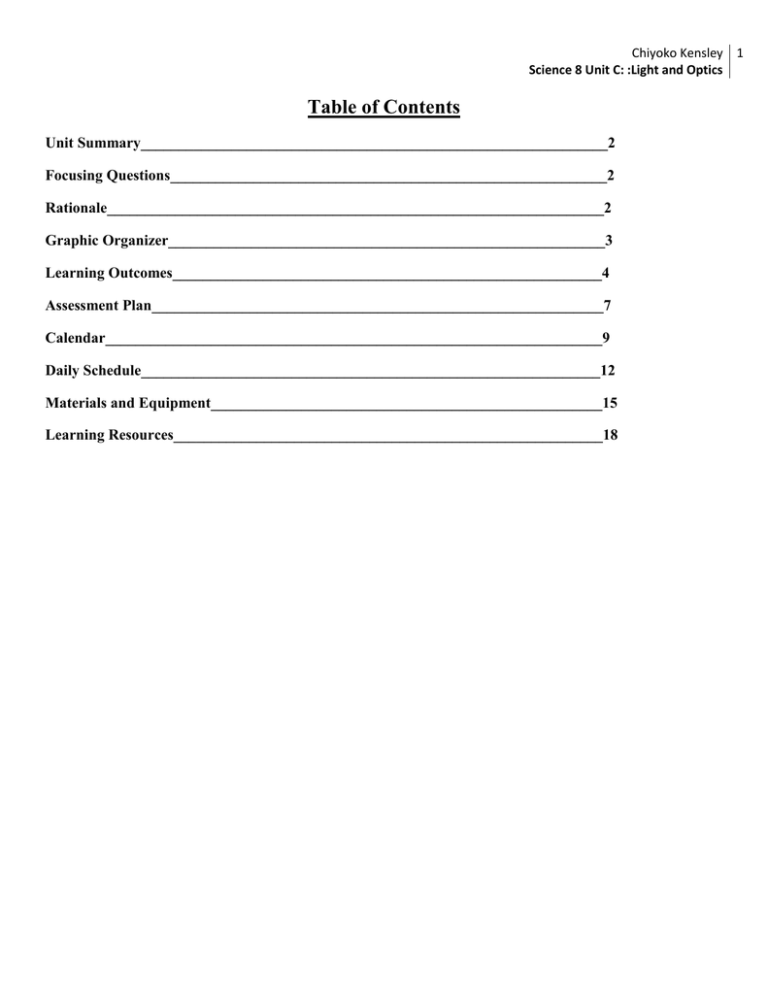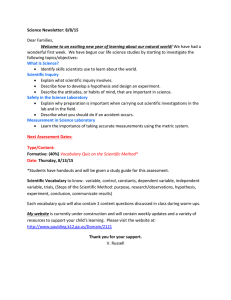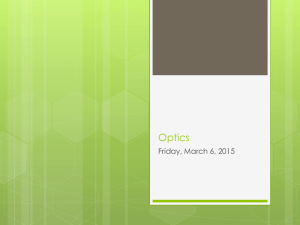Science 8 Unit C: :Light and Optics - Chiyoko Kensley
advertisement

Chiyoko Kensley 1 Science 8 Unit C: :Light and Optics Table of Contents Unit Summary______________________________________________________________2 Focusing Questions__________________________________________________________2 Rationale__________________________________________________________________2 Graphic Organizer__________________________________________________________3 Learning Outcomes_________________________________________________________4 Assessment Plan____________________________________________________________7 Calendar__________________________________________________________________9 Daily Schedule_____________________________________________________________12 Materials and Equipment____________________________________________________15 Learning Resources_________________________________________________________18 Chiyoko Kensley 2 Science 8 Unit C: :Light and Optics Unit Summary We use light and optical systems in our everyday lives because our understandings about the world around us are mainly derived from what we can see. Technology has provided us with numerous devices to extend our vision capabilities and knowledge about the world around us. Students will interact with a variety of materials to interpret the behaviour and principles of light. Students can use their understanding about light to interpret light-based technologies and envision new models of technologies for the future. Focusing Questions What are the properties of light? How do the technologies we develop show us the principals of light? How does light interact with our world and what are the scientific properties of these interactions? Rationale When designing this unit, I wanted to ensure I met all learning outcomes so I divided the unit into topics based on the order in Science Focus 8. I proceeded to organize the unit by methods of assessment which include: assignments (weekly questions, worksheets), labs, projects, quizzes and final exam. I chose to implement a variety of assessment and learning strategies as I am unsure of my students learning and interest profiles. I will continually be assessing my students to differentiate instruction in content, product, and process depending on my student’s strengths and weaknesses. When we read from the textbook we will do so as a class or I will ask for student volunteers. I cannot assume that all my students are grade level readers. It is important I learn about student interests and learning styles so I can incorporate learning activities that support them. I will be very flexible in changing my schedule but still ensure all learning outcomes are met. My goal is to conduct all assessments during class as I am unsure about homework routines and external social factors. I have planned to assign some homework as it is a requirement in for PSII student teachers. I have integrated FNMI culture into my lessons by using: talking circles, bringing in natural resources found in the environment, discussion relating to ancestral notions about the topic (perspectives about the sun), and incorporating historical understanding and importance of light and optic systems in the daily lives of First Nations people. Aboriginal groups are known to be an oral community where stories and knowledge are passed down through generations by elders and valued members of the tribe. I would like to have both class discussions and student presentations to hear my student’s perspectives and get a sense of their level of understanding about a topic. I have planned a lot of hands on learning activities to ensure students are engaged in the material and have an understanding of how the material relates to their everyday lives. I would like my students to work collaboratively to maximize their sense of understanding about light and optic systems. Chiyoko Kensley 3 Science 8 Unit C: :Light and Optics GRAPHIC ORGANIZER Science 8 Unit C: Light and Optical Systems (Nature of Science Emphasis) 1. INVENTIONS AND INVESTIGATIONS OF LIGHT K1. Investigate the nature of light and vision; and describe the role of invention, explanation and inquiry in developing our current knowledge View of light in the past. (1-1) Development of optical technology. (1-2, 2-4) Optical technologies role in society. (1-2, 2-4) Light as a beam. (1-3) Nature of light. (1-3) 2. BEHAVIOROF LIGHT Reflection of light. (2-1) o Angles of reflection on a: (2-2) Smooth surface. Rough surface. Transmission and absorption of light. (2-1) Refraction of light. (2-3) Light’s role in optical technologies. (2-4) 3. BIOLOGICAL AND TECHNOLOGICAL APPLICATIONS OF LIGHT Double convex lenses. (3-1) o Changes in lens positions effect on image formation. Microscopes (3-2) Eyeglasses, telescopes, and binoculars. (3-2) Eyes and cameras. (3-3) Mammalian and non-mammalian eyes. (3-4) Technologies and human vision. (3-5) Technologies and image storage. (3-6) Chiyoko Kensley 4 Science 8 Unit C: :Light and Optics Learning Outcomes Outcomes for Science, Technology and Society (STS) and Knowledge Students will: K1. Investigate the nature of light and vision; and describe the role of invention, explanation and inquiry in developing our current knowledge K K 1-1: identify challenges in explaining the nature of light and vision 1-2: investigate the development of microscopes, telescopes and other optical devices; and describe how these developments contributed to the study of light and other areas of science K 1-3: investigate light beams and optical devices, and identify phenomena that provide evidence of the nature of light K2. Investigate the transmission of light, and describe its behaviour using a geometric ray model K 2-1 investigate how light is reflected, transmitted and absorbed by different materials; and describe differences in the optical properties of various materials K 2-2: measure and predict angles of reflection K 2-3: investigate, measure and describe the refraction of light through different materials K 2-4: investigate materials used in optical technologies; and predict the effects of changes in their design, alignment or composition. K3. Investigate and explain the science of image formation and vision, and interpret related technologies K 3-1: demonstrate the formation of real images, using a double convex lens, and predict the effects of changes in the lens position on the size and location of images K 3-2: demonstrate and explain the use of microscopes; and describe, in general terms, the function of eyeglasses, binoculars and telescopes K 3-3: explain how objects are seen by the eye, and compare eyes with cameras K 3-4: compare the function and design of the mammalian eye with that of other vertebrates and invertebrates K 3-5: investigate and describe the development of new technologies to enhance human vision K 3-6: investigate and interpret emerging technologies for storing and transmitting images in digital form Skill Outcomes Skill Outcomes (focus on scientific inquiry) Initiating and Planning (IP) Students will: Ask questions about the relationships between and among observable variables, and plan investigations to address those questions IP-1: IP-2: IP-3: identify questions to investigate (e.g., ask about the role of eyeglasses in improving vision) define and delimit questions to facilitate investigation design an experiment, and identify the major variables Chiyoko Kensley 5 Science 8 Unit C: :Light and Optics IP-4: state a prediction and a hypothesis based on background information or an observed pattern of events IP-5: formulate operational definitions of major variables and other aspects of their investigations Performing and Recording (PR) Students will: Conduct investigations into the relationships between and among observations, and gather and record qualitative and quantitative data PR-1: PR-2: PR-3: PR-4: PR-5: carry out procedures, controlling the major variables observe and record data, and prepare simple line drawings use instruments effectively and accurately for collecting data organize data, using a format that is appropriate to the task or experiment use tools and apparatus safely Analyzing and Interpreting (AI) Students will: Analyze qualitative and quantitative data, and develop and assess possible explanations AI-1: AI-2: AI-3: predict the value of a variable by interpolating or extrapolating from graphical data identify strengths and weaknesses of different ways of collecting and displaying data state a conclusion, based on experimental data, and explain how evidence gathered supports or refutes an initial idea AI-4: identify new questions and problems that arise from what was learned Communication and Teamwork (CT) Students will: Work collaboratively on problems; and use appropriate language and formats to communicate ideas, procedures and results CT-1: CT-2: receive, understand and act on the ideas of others recommend an appropriate way of summarizing and interpreting their findings Attitude Outcomes Interest in Science Students will be encouraged to: Show interest in science-related questions and issues, and pursue personal interests and career possibilities within science-related fields Mutual Respect Students will be encouraged to: Appreciate that scientific understanding evolves from the interaction of ideas involving people with different views and backgrounds Scientific Inquiry Students will be encouraged to: Seek and apply evidence when evaluating alternative approaches to investigations, problems and issues Chiyoko Kensley 6 Science 8 Unit C: :Light and Optics Collaboration Students will be encouraged to: Work collaboratively in carrying out investigations and in generating and evaluating ideas Stewardship Students will be encouraged to: Demonstrate sensitivity and responsibility in pursuing a balance between the needs of humans and a sustainable environment Safety Students will be encouraged to: Show concern for safety in planning, carrying out and reviewing activities Chiyoko Kensley 7 Science 8 Unit C: :Light and Optics Assessment Plan Assessment Method Assignments Topic #1 What is Light? Questions : pg 186 SIA # 1, 4 pg 187 SIA # 2 In Class Questions and Worksheets (30%) Weighting 4% SLO’s Assessed K1: 1-1, 1-2, 1-3, K2: 2-1 Weekly in Class Questions Topic #2 Reflection BLM 3-5 Question #1 (SF) 4% Topic #3 Refraction KWL Chart Questions pg 201 BLM 3-1, 3-2 Topic #4 Lenses and Vision Far Out Lenses (Learn AB) and BLM- 3-12 and 3-16 4% K2: 2-1, 2-3, 2-4 K3: 3-1 AI-1, 3 IP-2,5 4% K3: 3-2, 3-3, 3-4 IP: 1, 2, 3, 4, 5 PR: 1, 2, 3, 4 AI: 1, 2, 3, 4 CT: 1, 2 3-F What an eyeful! Topic #5 Extending Human Vision Questions #1-5 (SF) p. 226 Topic #6 The Source of Colours Topic #7 The Wave Model of Light SPF Investigation (SF) P. 260-61 Date March15 K2: 2-1, 2-2, 2-3 PR-3 March 20 BLM 3-5 Work sheet Question #1 KWL Chart in class BLM: In class assignment and review March 28 April 2 4% 3% 4% K2: 2-1, 2-3, 2-4 K3: 3-1, 3-2, 3-3, 3-5, 3-6 IP: 1, 3, PR: 2, 4 K2: 2-4 K3: 3-5, 3-6 IP: 1, 2, 3, 4 PR: 1, 2, 3, 4, 5 AI:2, 3, 4 CT: 1, 2 Interest In Science Mutual Respect Scientific Inquiry Collaboration Stewardship Safety Questions DUE: April 11 April 11 Due: April 17 Chiyoko Kensley 8 Science 8 Unit C: :Light and Optics Topic #8 Beyond Light Infrared reflection Question p. 250 (SF) Labs (15%) Project (15%) Quiz (10%) 3% K2: 2-1, 2-4 K3: 3-5, 3-6 Due: April 23 5% K1: 1-1, 1-2, 1-3, K2: 2-1 Lab report due March 15 Light Reflection: What material is the best reflector of light? 5% Water Drop Magnifier 5% Emerging Technology and Light Presentation 15% K1: 1-1,1-2,1-3 K2; 2-1, 2-2, 2-3, 2-4 PR: 1,2,3,4,5 AI: 1,2,3,4 CT: 1,2 Interest in Science Scientific Inquiry K1: 1-1, 1-2, 1-3 K2: 2-1, 2-2 IP: 4, 5 PR: 1, 2, 3, 4, 5 AI: 3 CT: 1, 2 K3: 3-3, 3-6 IP: 1 AI: 4 CT: 2 p. 253 (SF) Extending Night Vision Light Up Your Life SelfReflection/Assessment Topic 1-3 Microscope Quiz Topic 4-8 BLM 3-28 Unit Exam (30%) 3% 2% 5% 30% K1: 1-1, 1-2, 1-3 K2: 2-1, 2-2, 2-3, 2-4 K3: 3-1, 3-2, 3-3 K2: 2-1, 2-3, 2-4 K3: 3-1, 3-2, 3-3, 3-5, 3-6 K1: 1-1, 1-2, 1-3 K2: 2-1, 2-2, 2-3, 2-4 K3: 3-1, 3-2, 3-3, 3-4, 3-5, 3-6 Lab report due March 22 Lab worksheet due March 26 April 5 March 27 March 29 April 19 April 24 Chiyoko Kensley 9 Science 8 Unit C: :Light and Optics Friday = No Class Monday =40 minutes Tuesday/Thursday =45 minutes Wednesday= 85 minutes (SF) Science Focus 8 Textbook (SIA) Science in Action ***March 7&8 = Building Classroom Community and Getting to Know Students (Interest Profile, Multiple Intelligence, Lab Safety Worksheet) Calendar March 12- April 25, 2012 Monday 12 Intro Light and Optics Systems Tuesday 13 Topic 1 What is Light? Video: Bill Nye the Science Guy on Light Beams SIA Inquiry Activity: Light Up Your Life pg 178 Twisted Rays pg: 175 SIA Lab Report Due on March 15 19 Topic 1 Pin hole camera SIA pg 185 20 Topic 2 Reflection Science Inquiry: Pg. 271 Make a Pinhole Camera Ray Model of Light SF 184-185 BLM 3-5 Ray Diagrams (SF) Weekly Questions for Assessment Wednesday 14 Topic 1 Thursday 15 Topic 1 Challenges of Light Early Investigators SIA 182-184 Optical Devices SIA 182-184 Sources of Light SF 179-183 21 Topic 2 Friday 16 No class Questions : pg 186 SIA # 1, 4 pg 187 SIA # 2 22 Topic 3 Refraction 23 No Class Angles of reflection Light Beams Concave and Convex Lenses Light Reflection Lab: Due Thursday March 22 Demo: Swollen finger p 276 Science Inquiry Water magnifier Lab Pg 279: Science Inquiry. Water drop magnifier (refraction) convex lens 26 Topic 3 Water Magnifier 27 Topic 3 28 Topic 4 29 Topic 4 30 No Class Chiyoko Kensley 10 Science 8 Unit C: :Light and Optics worksheet DueToday Topic 1-3 Quiz What is light? Questions/ review and vocab BLM (SF) 3-1 combine with 3-2 Lenses and Vision Microscope quiz Function of an Eye and Camera (SF) BLM 3-12 and 3-16 (Making Things Bigger) Eyeglasses Telescopes Binoculars Microscopes Lenses Eyes and Cameras 2 Topic 4 What an Eyeful (SF) p. 219 3 Topic 5 Extending Human Vision * Morning Computer Class, analysis and conclusion in pm Far out Lenses Learn Alberta : Simulate building a telescope using convex lenses to look at the moon 4 Topic 5 Nearsighted Farsighted Convex & Concave lenses 10 Topic 6 11 Topic 6 5 Topic 5 Emerging Technology and Light Presentation/ Poster (differentiated products) 12 Topic 7 The Source of colours Smartie Graph Lesson (Keith Roscoe) The Wave Model of Light Class time for project research Introduce Project and presentation 9 Blind Spot pg 217 (SF) 6 Good Friday No Class 13 No Class Easter Monday Colour PinWheel White Light Pg. 346 (Science Is) In Full Color 16 Topic 7 17 Topic 7 Finish SPF Testing SPF Science Investigation Focus page 260 18 Topic 8 Beyond Light Infrared Questions and Extending Night Vision 19 Topic 8 Topic 4-8 Quiz 20 No Class Chiyoko Kensley 11 Science 8 Unit C: :Light and Optics (Design Investigation) 23 Review for Unit Exam Practice/Example Question Review for quiz and unit exam 24 Unit Exam 25 Science fair** Practicum Ends Chiyoko Kensley 12 Science 8 Unit C: :Light and Optics Daily Schedule Dates: March 7, 2012- April 25, 2012 Monday =40 minutes Tuesday/Thursday =45 minutes Wednesday= 85 minutes Lesson Date and length March 7-9 March 12 March 13 March 14 AM &PM March 15 March 19 March 20 March 21 March 22 Content, Activities, Strategies, Evaluation/Assessment Building community activities Names, interests, likes/dislikes, learning styles Introduction Video: Bill Nye the Science Guy on Light Beams Twisted Rays Pg 175 SIA Black markers Paper Glass Beakers Water and Jug Student Checklist for Lab Report Assessment SIA Inquiry Activity: Light Up Your Life pg 178 Section A, B, D, E, F Challenges of Light Early Investigators SIA 177-181 Sources of Light SF 179-183 Optical Devices SIA 182-184 Pin hole camera SIA pg 185 Science Inquiry: Pg. 271 Make a Pinhole Camera Pg. 64 Catch a Shadow-Sponge activities Pg. 174 Shadows and Exploration- SP Activity Ray Model of Light SF 184-185 BLM 3-5 Ray Diagrams (SF) Pg. 273 Funny Reflections Light Beams Pg. 274 How High to Place the Mirror (Invitations to Science Inquiry) Light Reflection Lab SIA p. 192: What material is the best reflector of light? Demo: Swollen finger p 276 Science Inquiry Pg 200 (SF) Re-appearing coin Relevant SLO’s K1 Communication and Teamwork A1- Interest In Science A-3 Scientific Inquiry K1, 1-1, 1-3 K2, 2-1, 2-2, 2-3, K3, 3-1 K1, 1-1, 1-2, 1-3 K1: 1-2, 1-3 K1: 1-3 K2: 2-1, 2-4 PR-1 K2: 2-1, 2-2, 2-3 PR-3 K1: 1-1, 1-3 K2; 2-1, 2-2, 2-3, 2-4 PR: 1,2,3,4,5 AI: 1,2,3,4 CT: 1,2 Interest in Science Scientific Inquiry K2: 2-1, 2-3, 2-4 K3: 3-1 Chiyoko Kensley 13 Science 8 Unit C: :Light and Optics March 26 March 27 March 28 March 29 April 2 April 3 Pg. 201 When light refracts 3C Pg 62 (Science is…Broken Pencil) Pg 279; Science Inquiry- Water drop magnifier (refraction) convex lens. Lab Topic Quiz 1-3 Function of an Eye and Camera (SF) BLM 3-12 (Making Things Bigger) Microscopes Lenses Eyes and Cameras * Use Morning Computer Class, analysis and conclusion in pm Far out Lenses Learn Alberta : Simulate building a telescope using convex lenses to look at the moon Pg. 210 Career and Profile (SIA) Microscope Quiz Eyeglasses Telescopes Binoculars Blind Spot pg 217 (SF) Nearsighted Farsighted Convex & Concave lenses 3F (SF) What an eyeful! Use Computer period in am. Bring additional resources about different types of eyes (ex. Books, pictures, encyclopedias, students use internet) Introduce Project/presentation April 4 Class time for students to work on project. Book computer lab April 5 Class presentations: Emerging Technology and Light K1: 1-1, 1-2, 1-3 K2: 2-1, 2-2 IP: 4, 5 PR: 1, 2, 3, 4, 5 AI: 3 CT: 1, 2 K3: 3-1, 3-2, 3-3 AI: 2 CT: 1, 2 K3: 3-2, 3-3 K3: 3-2, 3-3, 3-4 IP: 1, 2, 3, 4, 5 PR: 1, 2, 3, 4 AI: 1, 2, 3, 4 CT: 1, 2 K3: 3-5 IP: 1 K3: 3-3, 3-5, 3-6 IP: 1 AI: 4 CT: 2 Attitudes: Interest In Science, Mutual Respect, Scientific Inquiry, Collaboration K3: 3-3, 3-5, 3-6 IP: 1 AI: 4 CT: 2 Attitudes: Interest In Science, Chiyoko Kensley 14 Science 8 Unit C: :Light and Optics April 10 April 11 April 12 April 16 April 17 April 18 April 19 April 23 April 24 The Source of colours Colour PinWheel &White Light Pg. 346 (Science Is) In Full Color Smarties: Graphing Activity (Keith Rosco) Wave Model of Light (SIA) Diagram page 216 Electromagnetic Spectrum Testing SPF Science Focus page 260 (Design Investigation) Finish SPF Investigation Review for exam Topic Quiz 4-8 Review for final exam Unit Exam Mutual Respect, Scientific Inquiry, Collaboration K3: 3-3, 3-5 PR:4 K2: 2-4 K3: 3-5, 3-6 K2: 2-4 K3: 3-5, 3-6 IP: 1, 2, 3, 4 PR: 1, 2, 3, 4, 5 AI:2, 3, 4 CT: 1, 2 Interest In Science Mutual Respect Scientific Inquiry Collaboration Stewardship Safety See SLO for April 16 Chiyoko Kensley 15 Science 8 Unit C: :Light and Optics Materials and Equipment Date March 7-9 March 12 Materials Needed Interest and Learner profile worksheets and getting to know you games/activities Powerpoint presentation about me. Introduction video: March 13 SIA Inquiry Activity: Light Up Your Life pg 178 Student Checklist for Lab Report Assessment Solar Calculators Laser beam Flash lights Mirrors 3 colors of tissue paper Concave and Convex lenses March 14 AM &PM Challenges of Light Early Investigators SIA 177-181 Sources of Light SF 179-183 March 15 Optical Devices SIA 182-184 March 19 Pinhole Camera Paper or Styrofoam cups Pin Rubber bands Wax Paper Light Bulb BLM 3-5 Ray Diagrams (SF) BLM 3-5 Key Protractors Full Length Mirror Light Source Light Meter Ruler Coloured construction paper Wax Paper Cloth Pieces of Wood Tin foil Glass Plastic March 20 March 21 Chiyoko Kensley 16 Science 8 Unit C: :Light and Optics March 22 March 26 March 27 March 28 March 29 April 2 April 4 April 5 April 10 April 11 April 12 April 16 Lasers Demo: Swollen finger p 276 Science Inquiry Glass olive jar Water Pg 200 SF The Re-appearing coin Cup or bowl with opaque sides Coins Pg 201 (SF) when light refracts Pencils Clear Plastic cups Pg 279; Science Inquiry- Water drop magnifier (refraction) convex lens. Lab Wax paper News print Water and droppers Worksheet/lab procedure Topic 1-3 Quiz Far out Lenses : Learn Alberta * Use am computer class Microscope, telescope, camera, eye diagram Microscope Quiz Use Computer period in am. ( Books, pictures, encyclopedias, students use internet) Use Computer period in am. ( Books, pictures, encyclopedias, students use internet) Poster paper Felt Markers Art Supplies Magazines Scissors Glue Use Computer period in am. ( Books, pictures, encyclopedias, students use internet) Poster paper Felt Markers Art Supplies Magazines Scissors Glue Pencil crayons FeltMarkers Pencils circle template Graphing Paper Rulers Smarties Testing SPF Science Focus page 260 (Design Investigation) Chiyoko Kensley 17 Science 8 Unit C: :Light and Optics April 17 April 18 April 19 April 23 April 24 Petri Dishes Scissors Stop watch Photosensitive paper 5 Sunscreen products SPF Investigation Due Review for quiz and unit exam Topic Quiz 4-8 Exam Outline Final Unit Exam Chiyoko Kensley 18 Science 8 Unit C: :Light and Optics Learning Resources Bosak, S. V. (1991). Science is-- (2nd ed.). Richmond Hill, Ont.: Scholastic Canada. Liem, T. L. (19871992). Invitations to science inquiry (2nd ed.). Chino Hills, Calif.: Science Inquiry Enterprises. McGraw-Hill Ryerson. (2001). Science Focus 8: Science, Technology, Society. Taylor, B., & Millard, P. (1990). Color and light. New York: Franklin Watts. Ward, A., & Flax, Z. (1991). Experimenting with Science About Yourself. New York: Chelsea Juniors Division, Chelsea House Publishers. Wesley, A.(2001). Science in Action 8. Toronto, Canada. http://www.opticalres.com/optics_for_kids/kidoptx_p1.html http://www.micromagnet.fsu.edu/optics/acticities/teachers/scopes.html http://www.edquest.ca/component/content/article/198 http://www.nasa.gov/audience/foreduls/listbytype/Simple-magnifiers.html http://www.proteacher.org/c/657_Light_and_Sound.html http://www.sciencekidks.com.nz/light.html http://www.lpi.usra.edu/education/explore/our_place/activity-glance.shtml http://www.explainthatstuff.com http://www.billnye.com/for-kids-teachers/episode-details/







